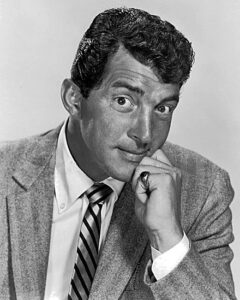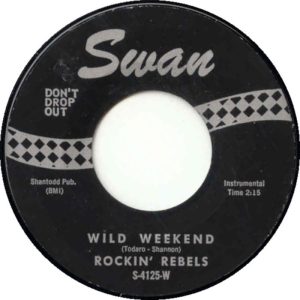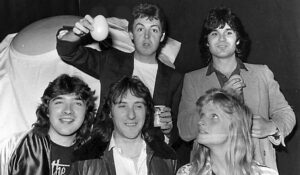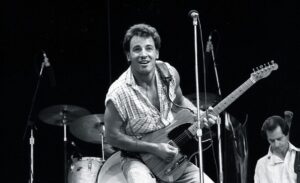
Martin was born Dino Paul Crocetti on June 7, 1917, in Steubenville. Ohio the son of Italian father Gaetano Alfonso Crocetti (1894–1967) and Italian-American mother Angela Crocetti (néeBarra; 1899–1966). His parents were married in 1914. His father, who was a barber, was originally Montesilvano and his mother’s origins are believed to be from Abruzzo, although they are not clearly known. Martin had an older brother named William Alfonso Crocetti (1916–1968). His first language was Abruzzese, a dialect of Neopolitan and he did not speak English until he started school at the age of five.
He attended Grant Elementary School in Steubenville, where he was bullied for his broken English. As a teenager, he played the drums as a hobby. He dropped out of school in the tenth grade because he thought he was smarter than his teachers. He bootlegged liquor, worked in a steel mill, served as a croupier at a speakeasy and a blackjack dealer, and was a welterweight boxer.
At 15, he billed himself as “Kid Crochet”. His prizefighting earned him a broken nose (later straightened), a scarred lip, many broken knuckles (a result of not being able to afford tape used to wrap boxers’ hands), and a bruised body. Of his 12 bouts, he said that he “won all but 11”. For a time, he shared a New York City apartment with Sonny King who was also starting in show business and had little money. The two reportedly charged people to watch them bare-knuckle box each other in their apartment, fighting until one was knocked out. Martin knocked out King in the first round of an amateur boxing match.
Martin gave up boxing to work as a stickman and croupier in an illegal casino behind a tobacco shop, where he had started as a stock boy. At the same time, he sang with local bands, calling himself “Dino Martini. He got his break working for the Ernie MacKay Orchestra. He sang in a crooning style influenced by Harry Mills of the Mills Brothers among others. In the early 1940s, he started singing for bandleader Sammy Watkins who suggested he change his name to Dean Martin.
In October 1941, Martin married Elizabeth “Betty” Anne McDonald in Cleveland, Ohio and they eventually had four children before the marriage ended in 1949. Martin worked for various bands throughout the early 1940s, mostly on looks and personality until he developed his own singing style. He flopped at the Riobamba nightclub in New York, when he followed Frank Sinatra in 1943, but it was the setting for their meeting. Martin was drafted into the Army in 1944 during serving a year in Akron, Ohio. He was reclassified as 4-F and discharged, possibly because of a double Hernia. Jerry Lewis referred to the surgery Martin needed for this in his autobiography. By 1946, Martin was doing well, but he was little more than an East Coast Night club singer with a common style similar to Bing Crosby.
Martin attracted the attention of MGM and Columbia pictures but a Hollywood contract was not forthcoming. He met comic Jerry Lewis at the Glass Hat Club in New York, where both were performing. He and Lewis formed a fast friendship which led to their participation in each other’s acts and the formation of a music-comedy team. Martin and Lewis’s debut together occurred at Atlantic City’s 500 Club on July 24, 1946, and they were not well received. The owner, Skinny D’Amato, warned them that if they did not come up with a better act for their second show that night, they would be fired. Huddling in the alley behind the club, Lewis and Martin agreed to “go for broke”, they divided their act between songs, skits, and ad-libbed material. Martin sang and Lewis dressed as a busboy, dropping plates and making a shambles of Martin’s performance and the club’s decorum until Lewis was chased from the room as Martin pelted him with breadrolls.
They did slapstick, reeled off old jokes, and did whatever else popped into their heads. The audience laughed. This success led to a series of well-paying engagements on the Eastern seaboard, culminating in a run at New York’s Copacabana. The act consisted of Lewis interrupting and heckling Martin while he was trying to sing, with the two ultimately chasing each other around the stage. The secret, both said, is that they ignored the audience and played to each other.
The team made its TV debut on the first broadcast of CBS-TV network’s The Ed Sullivan Show (then called The Toast Of The Town) on June 20, 1948, Hoping to improve their act, the two hired young comedy writer Norman Lear and Ed Simmons to write their bits. With the assistance of both Lear and Simmons, the two would take their act beyond nightclubs.
They controlled their club, record, radio, and television appearances, and through these they earned millions of dollars. In Dean & Me, Lewis calls Martin one of the great comic geniuses of all time. They were friends, as well, with Lewis acting as best man when Martin remarried in 1949. But harsh comments from critics, as well as frustration with the similarity of Martin and Lewis movies, which producer Hal Wallis refused to change, led to Martin’s dissatisfaction. He put less enthusiasm into the work, leading to escalating arguments with Lewis. Martin told his partner he was “nothing to me but a dollar sign”. The act broke up in 1956, ten years to the day from the first teaming.
Martin was still popular as a singer, but the era of the pop crooner was waning. Despite that he had many hits in the fifties and prior to rock an roll dominating the hit parade had number one hits such as Memories are Made of This, That’s Amore and others.
Martin wanted to become a dramatic actor, known for more than slapstick comedy films. Though offered a fraction of his former salary to co-star in a war drama, The Young Lions (1958). Tony Randall already had the part, but talent agency MCA realized that with this film, Martin would become a triple threat: they could make money from his work in nightclubs, films, and records. Martin replaced Randall and the film turned out to be the beginning of Martin’s comeback.
Martin starred alongside Sinatra for the first time in drama, Some Came Running (1958). By the mid-1960s, Martin was a movie, recording, television, and nightclub star. Martin was acclaimed as Dude in Rio Bravo (1959), directed by Howard Hawks also starring John Wayne and Ricky Nelson.
Sinatra and he teamed up for several more movies, the crime cape, Ocean’s Eleven, the musical Robin and the Hoods, and the Western comedy, 4 for Texas, often with their Rat Pack pals such as Sammy Davis, Peter Lawford and Joey Bishop.He poked fun at his image in films such as the Matt Helm Spy Spoofs of the 1960s, in which he was a co-producer.
As a singer, Martin could hold his own in duets with Sinatra and Crosby. Like Sinatra, he could not read music, but he recorded more than 100 albums and 600 songs.
For nearly a decade, Martin had recorded as many as four albums a year for Reprise Records. That stopped in November 1974, when Martin recorded his final Reprise album which was released in 1978. He played a featured role in the 1981 film The Cannonball Run and its’ sequel, both starring Burt Reynolds..
In 1972, he filed for divorce from his second wife, Jeanne. A week later, his business partnership with the Riviera hotel in Law Vegas dissolved amid reports of the casino’s refusal to agree to Martin’s request to perform only once a night. He was taken by the MGM Rand Hotel, where he was the featured performer on the hotel’s opening night December 23, 1973, and also agreed to star in a picture for Metro-Goldwyn-Mayer studios. Less than a month after his second marriage had dissolved, Martin was 55 when he married 26-year-old Catherine Hawn, on April 25, 1973. Hawn had been the receptionist at the chic Gene Shacove hair salon in Beverly Hills. They divorced November 10, 1976. He was also briefly engaged to Gail Renshaw, Miss U.S.A. 1969. Eventually, Martin reconciled with Jeanne, though they never remarried.
He also made a public reconciliation with Lewis on the Jerry Lewis MDA Telethonin 1976. Sinatra shocked Lewis by bringing Martin out on stage. As Martin and Lewis embraced, the audience cheered and the phones lit up, resulting in one of the telethon’s most profitable years. Lewis reported the event was one of the three most memorable of his life. Lewis quipped, “So, you working?” Martin, playing drunk, replied that he was “at the Meggum” (meaning the MGM Grand). This, with the death of Martin’s son, Dean Paul more than a decade later, helped bring the two men together. They maintained a quiet friendship, but only performed again once, in 1989, on Martin’s 72nd birthday.
Martin, a heavy smoker, was diagnosed wit lung cancer at Cedars Sinai Medical Center in September 1993, and was told that he would require surgery to prolong his life, but he rejected it. He retired from public life in early 1995 and died of at his Beverly Hills home on Christmas Day, 1995 at the age of 78 The lights of the Las Vegas Strip were dimmed in his honor.
Here is a Martin favorite, Memories are Made of This. Enjoy (or not.)


 Bruce Frederick Joseph Springsteen was born on September 23, 1949, at Monmouth Medical Center in Long Branch, New Jersey. He lived on South Street and attended Freehold Borough High School. His father, Douglas Frederick Springsteen (1924-1998), was of Dutch/Irish ancestry, and worked as a bus driver, among other vocations, but was unemployed most of the time. Springsteen said his mother, Adele Ann (née Zerilli), a legal secretary and of Italian ancestry, was the main breadwinner. He has two younger sisters, Virginia and Pamela. Pamela had a brief film career, but left acting to pursue still photography full-time. Bruce’s father, suffered from mental health issues through his life which worsened in his later years.
Bruce Frederick Joseph Springsteen was born on September 23, 1949, at Monmouth Medical Center in Long Branch, New Jersey. He lived on South Street and attended Freehold Borough High School. His father, Douglas Frederick Springsteen (1924-1998), was of Dutch/Irish ancestry, and worked as a bus driver, among other vocations, but was unemployed most of the time. Springsteen said his mother, Adele Ann (née Zerilli), a legal secretary and of Italian ancestry, was the main breadwinner. He has two younger sisters, Virginia and Pamela. Pamela had a brief film career, but left acting to pursue still photography full-time. Bruce’s father, suffered from mental health issues through his life which worsened in his later years.